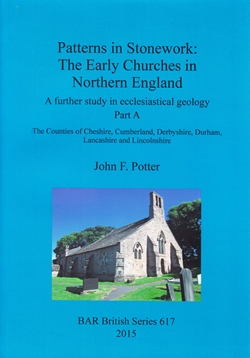 In his recent book The Road to Little Dribbling, author Bill Bryson remarks: “If you tried to visit all the mediaeval churches in England – just England – at the rate of one a week, it would take you 308 years”. The indefatigable John Potter, in his continuing quest to prove Mr Bryson wrong, has now followed his surveys of the churches of Ireland, and of Early Welsh Churches (2013, reviewed 2014) with this survey of England’s northern counties. This is part A – Part B, covering Northumberland, Nottinghamshire, Staffordshire, Westmorland and Yorkshire, is expected in 2016.
In his recent book The Road to Little Dribbling, author Bill Bryson remarks: “If you tried to visit all the mediaeval churches in England – just England – at the rate of one a week, it would take you 308 years”. The indefatigable John Potter, in his continuing quest to prove Mr Bryson wrong, has now followed his surveys of the churches of Ireland, and of Early Welsh Churches (2013, reviewed 2014) with this survey of England’s northern counties. This is part A – Part B, covering Northumberland, Nottinghamshire, Staffordshire, Westmorland and Yorkshire, is expected in 2016.
Once again, Potter uses his geologist’s eyes to help archaeologists (whose lithological observations are generally spurious) recognise ‘Anglo Saxon’ (pre-Romanesque) building work where no classically recognised architectural details survive: using such features as ‘patterned’ use of stone (alternating ‘long and short’ work in the quoins) as touchstone.
Identifying lithologies in early churches is no simple matter even for an experienced geologist like Potter. In Wales, he found himself faced with its less-than-forthcoming Palaeozoic limestones and greywackes, rendered (pun intended) even more intractable by the lamentable local habit, encouraged by CADW, of limewashing. Here, he faced a different problem.
Lower Cretaceous rocks of Lincolnshire are poorly exposed and difficult to identify. In church walls (sampling, of course, not permitted!) and in their weathered state, they are virtually impossible to name accurately. This problem is not unique to this region, where Lower Cretaceous – Jurassic ironstones can hardly be distinguished without fossils. Middle Jurassic oolites of the ‘stone belt’ pose similar problems. Potter asks – could there be a case for professional geologists being allowed to sample? Perhaps minor chips, following a formal application? He suspects (with good reason) that the answer would probably be no.
The hundreds of churches surveyed are illustrated in crisp B&W photos within the text, accompanied by perceptive descriptions of their stonework. Potter draws attention to the fact that Cheshire and Lancashire, with negligible ‘Anglo Saxon’ remains, contrast markedly with the riches of Durham and Lincolnshire. He suggests that while this may reflect contemporary population size, it may also be a function of the availability of good stone. Local rock types in Cheshire and Lancashire are inappropriate for building and not durable; early churches, if they existed, would almost certainly have been completely rebuilt later.
Potter’s survey endorses the existence of distinctive ‘patterned’ stonework seen elsewhere in pre-Norman building, while Norman and later churches display changes in building fashion similar to those noted in his previous studies. At £55, this volume represents excellent value and can be highly recommended to serious amateurs of ecclesiastical architecture everywhere.
Reviewed by Ted Nield
PATTERNS IN STONEWORK: THE EARLY CHURCHES IN NORTHERN ENGLAND – A FURTHER STUDY IN ECCLESIASTICAL GEOLOGY PART A: THE COUNTIES OF CHESHIRE, CUMBERLAND, DERBYSHIRE, DURHAM, LANCASHIRE AND LINCOLNSHIRE by JOHN F POTTER 2015 BAR British Series 617 ISBN 978 1 4073 1393 1 W: www.barpublishing.com 314pp List Price: £55.00